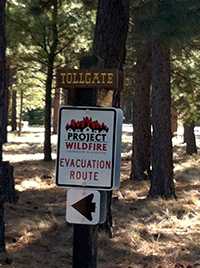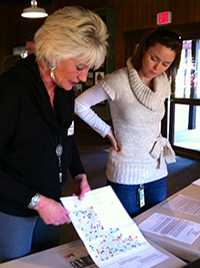On the Road in Bend, Oregon
By: Cori Wigington

Project Wildfire Evacuation sign posted in the Tollgate community.
Since starting with CDC almost 5 years ago, I have had some great opportunities, but one of the most rewarding and awe-inspiring experiences has been traveling into the field as part of OPHPR’s Whole Community Program.
Recently, my colleague Victoria Harp and I visited Bend, OR to learn about Project Wildfire. As a northeasterner at heart (go Red Sox!), I was new to the pacific northwest, but after spending a few days with Katie Lighthall, Ed Keith and their Project Wildfire partners, I learned a lot and can see why these people love this area and call it home.
Katie Lighthall is the Program Director for Project Wildfire and Ed Keith is the Forester for Deschutes County and Project Wildfire Steering Committee Chairman. Katie and Ed are firm believers in the old adage “Give a man a fish and you feed him for a day. Teach a man to fish and you feed him for a lifetime.” They learned early on how ineffective and costly it is to go into a community and do the work for them. Instead, through Project Wildfire, they are helping residents solve their own problems by teaching about wildfire risk, providing tips on how to protect homes and neighborhoods from fire, and providing convenient and affordable resources.
While in Bend, Katie and Ed took us to visit the community of Tollgate in Sisters, OR. We met with Tollgate community members and toured their neighborhood. What we found there is an exceptional example of a community that has embraced Project Wildfire and taken it to the next level. The sheer number of Tollgate’s wildfire prevention activities is astounding. Here are a few highlights that really stand out:
- Residents regularly participate in Project Wildfire events where they are responsible for clearing their own yards of flammable debris (i.e. pine needles, brush, etc.). The debris are dropped at pick-up points (for free or discounted price) or left at the curb-side for pick up.
- Residents share fond stories of engaging in friendly competition with each other to see who can have the cleanest yard (I was told the prize is bragging rights).
- Tollgate is one of the first Project Wildfire communities to display evacuation signs to assist residents in a safe and efficient wildfire evacuation.

Tollgate Business Manager, Betty Fadeley, showing Cori Wigington the residence map of homes at risk for fire damage and/or those requiring extra assistance in case of an emergency.
- Tollgate business manager Betty Fadeley has created a color-coded residence map that is shared with fire and emergency services and depicts homes that may be at higher risk for fire damage or individuals who may need assistance.
- The Tollgate Home Owner’s Association requires that all homeowners comply with community-imposed fire standards or face a fine.

Tollgate residence map outlining each home and risk status.
The Tollgate Community and Project Wildfire leaders share mutual admiration for one another and are proud of what they have been able to accomplish together.
Although I did my homework on Project Wildfire and the central Oregon area prior to this visit, all of the reading and Google-searching in the world could not have prepared me for what I was able to experience on-site. It was truly impressive to witness the sense of community, the way neighbors help neighbors, and how they hold one another accountable for their actions. It was a truly a case of having to see it to believe it. Learn more about Project Wildfire by checking out their website and CDC’s Public Health Matters blog.
Other Fun Facts I learned while in Central Oregon:
- Unlike Portland, Bend is known for its sunshine
- Juniper trees in central Oregon are considered common and thirsty weeds! They drink vast amounts of water depriving native plants of proper hydration. After decades of fire suppression, fire officials rely on prescribed fires, (fires set intentionally to accomplish an ecological objective), as one mechanism to control the quick spread of Junipers.
Corinne Wigington works as a Training Evaluator for the Learning Office within the Office of Public Health Preparedness and Response (OPHPR) at CDC. In this role, Ms. Wigington is responsible for aspects of the design, development, implementation and analysis of training programs for both internal CDC workforce as well as external partners.
- Page last reviewed: April 10, 2015
- Page last updated: April 10, 2015
- Content source:


 ShareCompartir
ShareCompartir